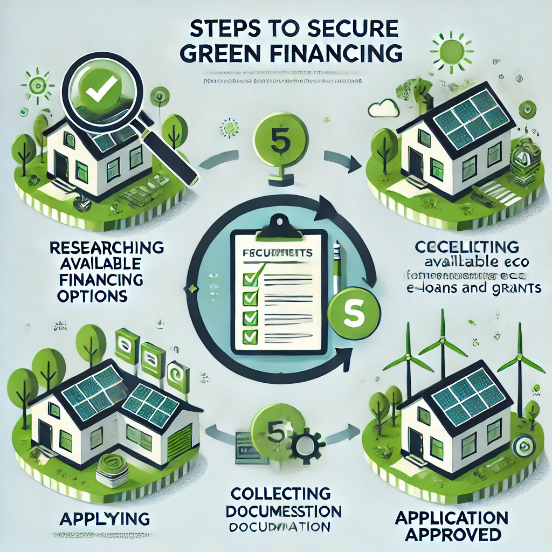Navigating Green Financing Options
Financial Resilience ?? Comments 15/Sep/2025 MonGreen financing options make it easier for homeowners and businesses to fund energy-efficient projects and renewable energy installations. These options often provide lower interest rates, special repayment terms, or direct financial assistance to encourage sustainability-focused investments. Below are practical steps to effectively navigate green financing opportunities.
Practical Steps
- Apply for Eco-Loans Through Banks Offering Special Rates for Energy-Efficient Projects
Eco-loans, also known as green loans, are specifically designed to finance environmentally friendly home improvements. Many banks, credit unions, and financial institutions offer these loans at reduced interest rates to incentivize investments in energy-efficient upgrades or renewable energy systems.
- Features: Eco-loans can cover projects such as installing solar panels, upgrading insulation, replacing HVAC systems, or purchasing energy-efficient appliances. Loan amounts and terms vary by lender, but many offer flexible repayment schedules and no prepayment penalties.
- Examples:
- Some banks partner with green certification programs like ENERGY STAR, offering preferential rates for certified projects.
- Local credit unions often have specialized programs for their communities, such as no-interest loans or rebates for energy-efficient improvements.
-
Application Tips: Before applying, prepare a detailed proposal outlining the planned project, costs, and potential energy savings. Lenders may also require documentation, such as contractor quotes or proof of certification for eligible products.
-
Research Grants Like the DOE’s Weatherization Assistance Program (WAP)
Grants are an excellent way to reduce the upfront costs of energy-efficient projects. The U.S. Department of Energy’s Weatherization Assistance Program (WAP) is one of the most well-known resources, providing financial assistance to low-income households for energy-efficient upgrades.
- What WAP Covers: The program funds a range of energy-saving measures, including:
- Insulating walls, attics, and floors.
- Sealing air leaks around windows and doors.
- Upgrading heating and cooling systems to more efficient models.
- Installing energy-efficient lighting and appliances.
- Eligibility: Households must meet specific income requirements, typically based on federal poverty guidelines. Priority is often given to families with elderly members, individuals with disabilities, or children.
-
How to Apply: Homeowners can apply through their state’s weatherization agency, which coordinates local service providers to perform energy assessments and implement upgrades.
-
Explore Property Assessed Clean Energy (PACE) Financing
PACE programs allow homeowners to finance energy-efficient and renewable energy projects through their property taxes. This financing option eliminates the need for upfront payments and spreads the cost over several years.
- Benefits:
- No upfront costs.
- Long repayment terms (up to 20 years).
- Payments are tied to the property, not the homeowner, which can be advantageous if the property is sold.
- Eligible Projects: Solar panel installations, energy-efficient HVAC systems, and weatherization improvements are common projects funded through PACE.
-
Availability: PACE programs are available in many states, but their terms and eligibility requirements vary. Homeowners should verify if their state or local government participates.
-
Look for Utility Company Financing Programs
Many utility companies offer on-bill financing or rebate programs to encourage energy-efficient upgrades. On-bill financing allows customers to repay the cost of improvements through their monthly utility bills.
- Benefits:
- No separate loan to manage.
- Payments are spread out and offset by energy savings.
-
Examples: Programs may fund upgrades like high-efficiency water heaters, smart thermostats, and insulation. Check with your local utility provider for available options.
-
Consider Federal and State Loan Programs
In addition to grants, federal and state governments often provide low-interest loans for energy-efficient and renewable energy projects.
-
Examples:
- The U.S. Department of Agriculture (USDA) offers loans and grants for rural homeowners and businesses through its Rural Energy for America Program (REAP).
- Many states have green banks or energy finance authorities that provide affordable loans for residential and commercial energy projects.
-
Take Advantage of Employer-Sponsored Programs
Some employers offer green benefit programs, such as interest-free loans or subsidies for purchasing energy-efficient products or installing renewable energy systems. Check with your human resources department to see if these programs are available.
- Consult Online Tools and Resources for Green Financing
Utilize online platforms like the Database of State Incentives for Renewables & Efficiency (DSIRE) to find and compare financing options in your area. These resources provide comprehensive information about loans, grants, rebates, and tax credits for energy-efficient projects.
Key Benefits of Green Financing Options
-
Accessibility: Green financing options make energy-efficient upgrades and renewable energy installations more affordable by reducing or eliminating upfront costs.
-
Lower Borrowing Costs: Eco-loans and other green financing programs often offer lower interest rates and favorable terms compared to traditional loans, making investments more economical.
-
Environmental Impact: Financing programs promote widespread adoption of energy-efficient and renewable energy technologies, contributing to reduced carbon emissions and a more sustainable future.
-
Long-Term Savings: By investing in energy-saving upgrades through green financing, households can achieve significant reductions in energy bills, leading to long-term financial benefits.
By navigating these financing options effectively, homeowners can take advantage of programs that reduce costs, improve energy efficiency, and contribute to environmental sustainability.
- Example: A household qualified for an eco-loan, enabling them to install a high-efficiency heat pump.
- Steps to secure green financing:
- Research available financing options.
- Check eligibility for eco-loans and grants.
- Collect necessary documentation.
- Apply for funding and wait for approval.
- Implement the energy-saving project.

Tags: energy green finance loans